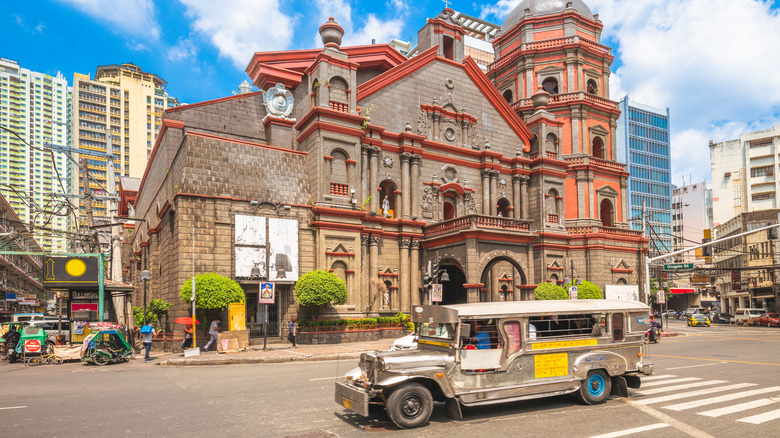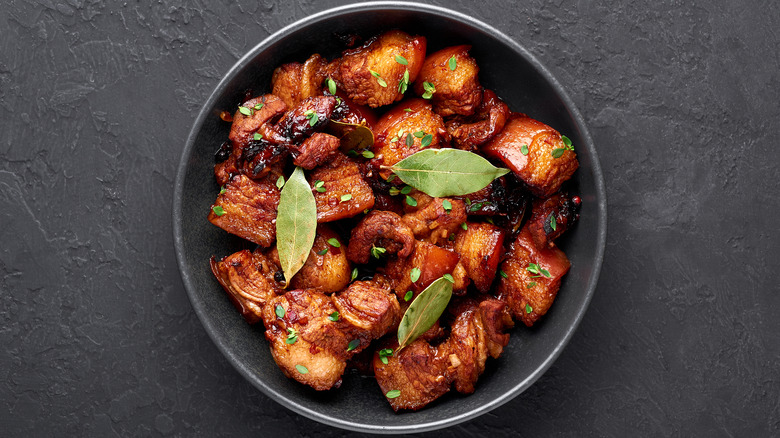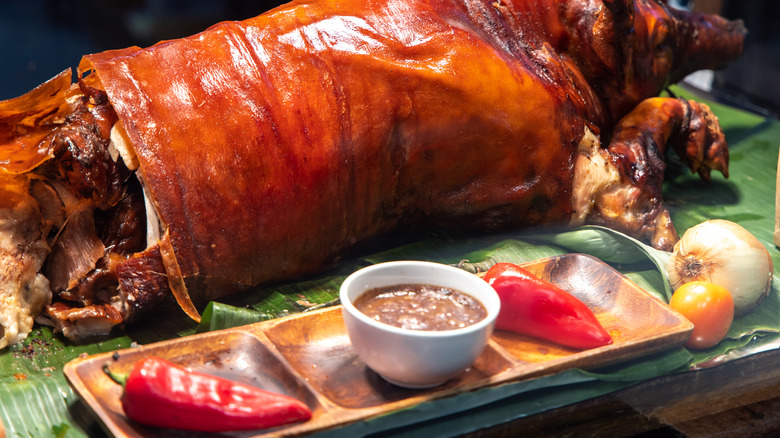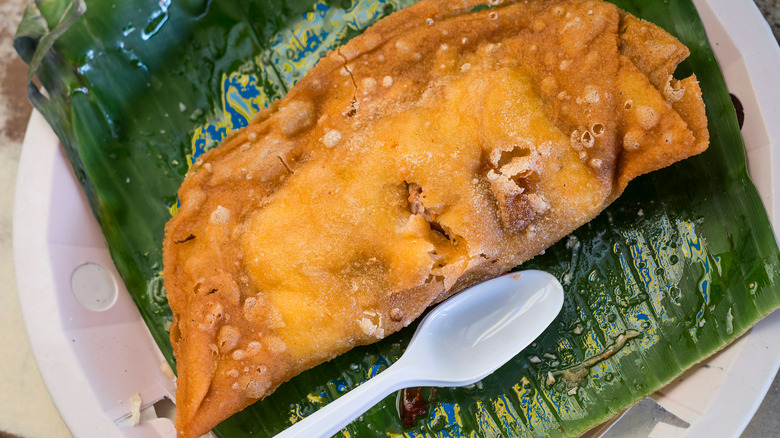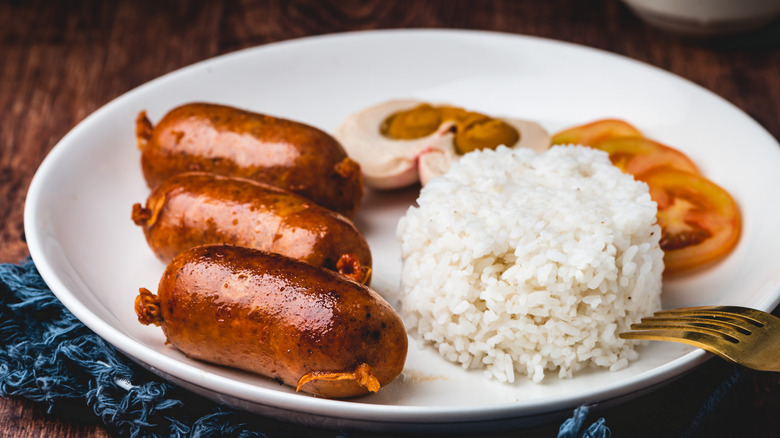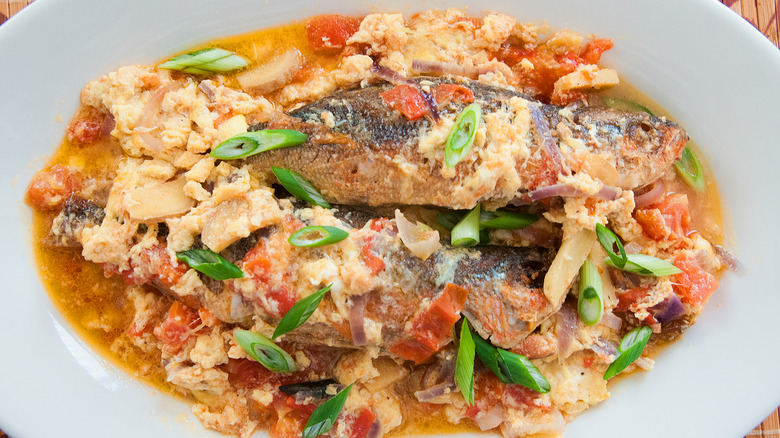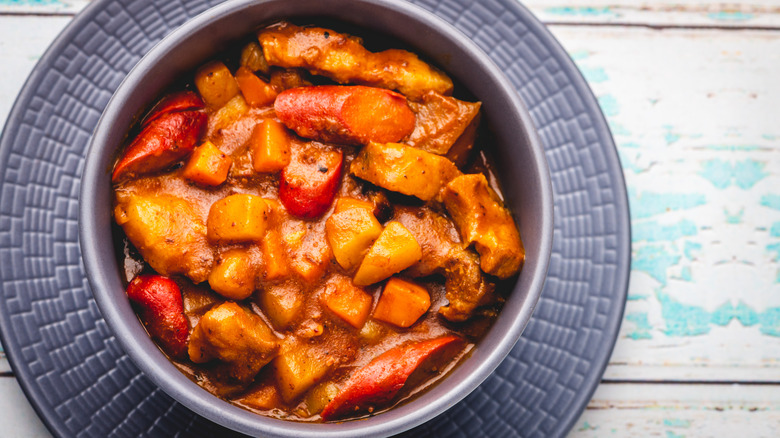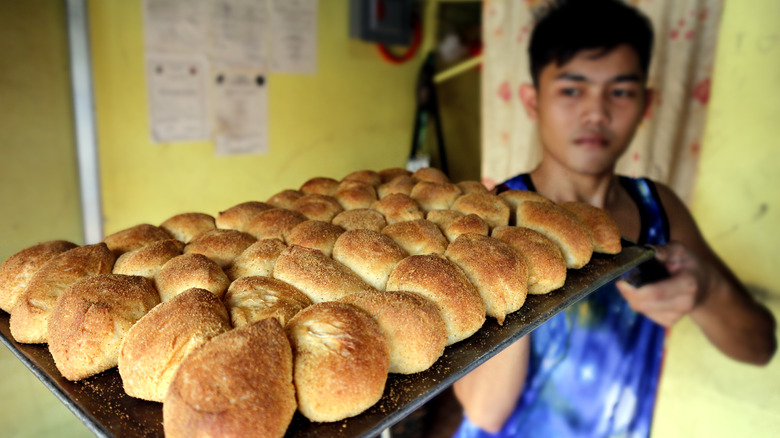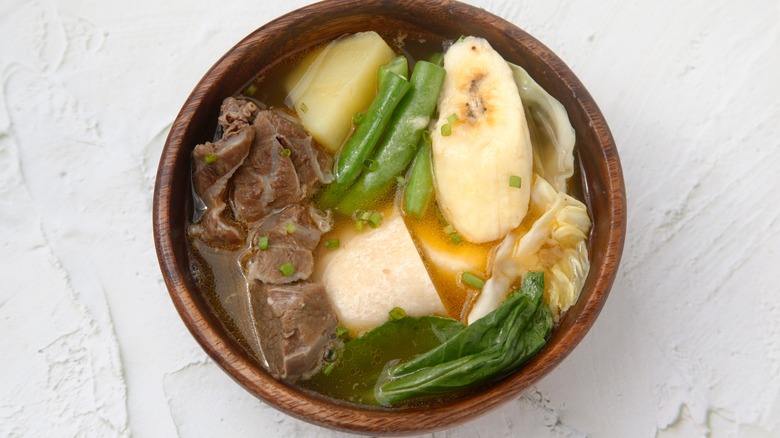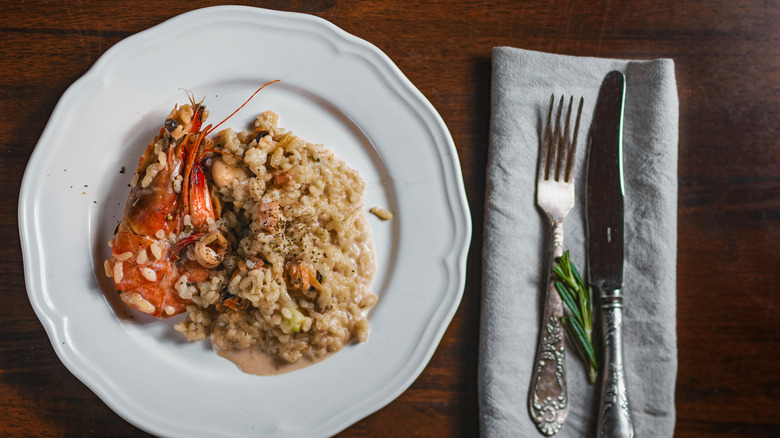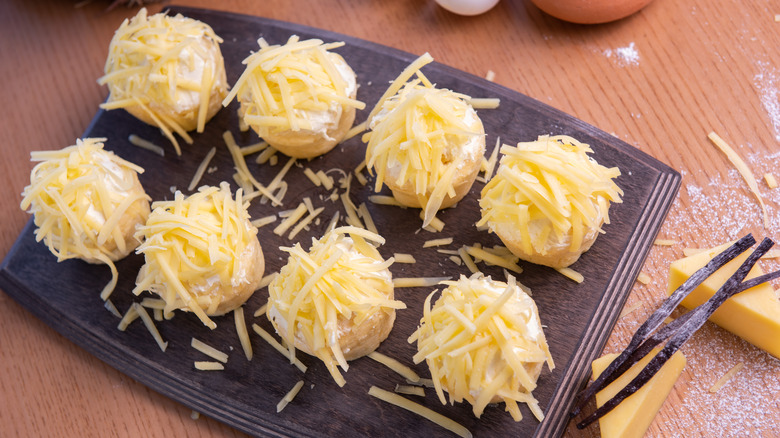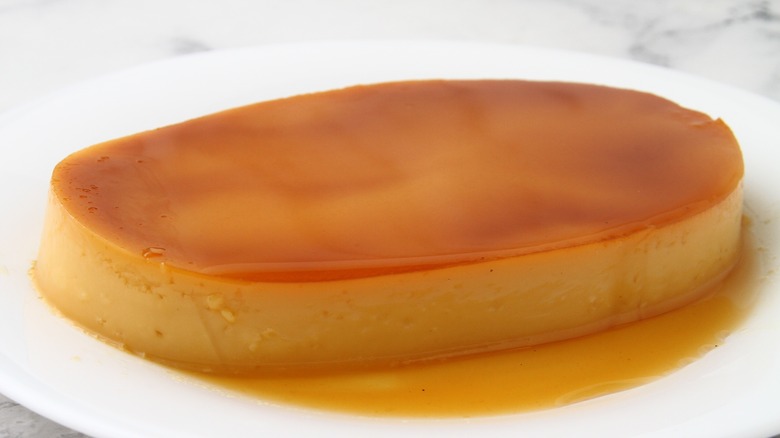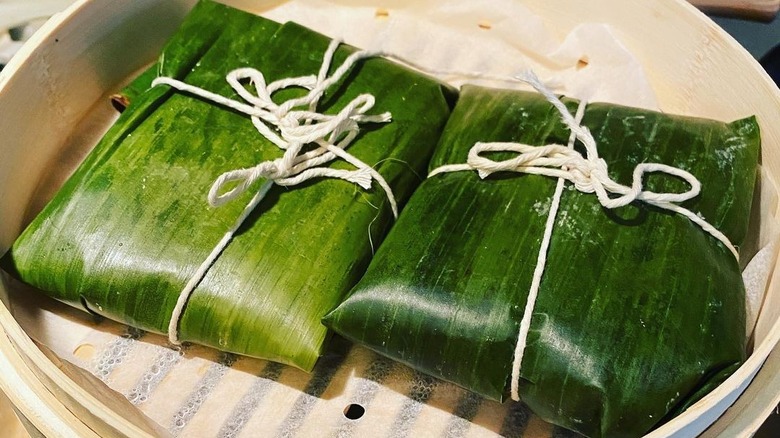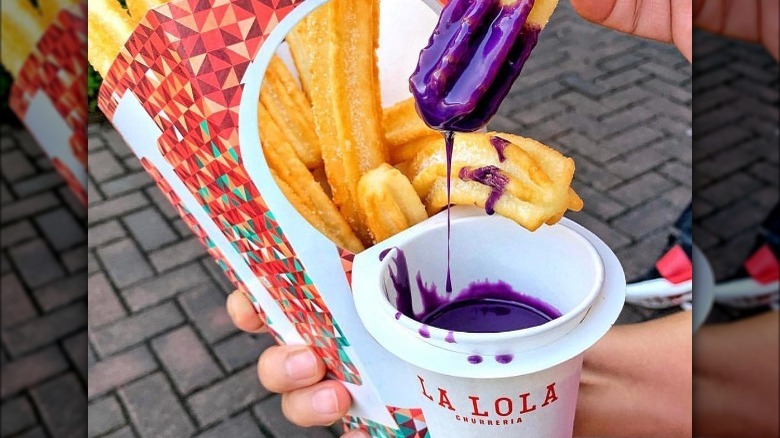13 Filipino Dishes With Hispanic Influence
Pull up a global map and put your finger on the Philippines. Looking at its location, you might assume food in the archipelagic country is heavily influenced by its neighbors: China, Indonesia, Vietnam, and Japan. However, one of the biggest influences on Filipino food is located thousands of miles away: Spain. From 1571 to 1898, the Philippines were a Spanish colony, and the island nation absorbed many culinary elements of the Spanish empire, like warm rice soaking up a bowl of Filipino menudo.
The Spanish brought many non-Asian ingredients to the Philippines which kicked off a culinary revolution. Tomatoes aren't native to Southeast Asia, but they fit right in with the traditional sour soups of the Philippines. Spanish beef wasn't wholly appreciated at first, but beef eventually made its way into all kinds of now-classic Filipino dishes. The Europeans also brought the bounty of their other colonies, including tropical New World fruits and vegetables like guava, pineapple, papaya, sweet potato, and avocado (via South China Morning Post).
In addition to bringing new ingredients, the Spanish also brought culinary techniques. Adobo involves stewing meats and vegetables in a vinegar-based liquid, and when Filipinos began adding soy sauce to the equation, it took on a life of its own, with adobo now considered to be the national dish of the Philippines. Bread baking was also introduced by the Spanish, and the use of various bread doughs has become a defining characteristic of Filipino food.
Adobo
Although the Philippines has no officially recognized national dish, it's widely considered to be the stew known as adobo, more specifically chicken or pork adobo. The origins of Filipino adobo can be traced back to the Spanish occupation, and even further back than that. When Chinese traders brought soy sauce to the islands, it quickly became a go-to alternative for salt. Later, the Spanish introduction of stewing meat in vinegar largely completed the puzzle of Filipino adobo. Modern adobo recipes also include garlic, bay leaves, and black peppercorns as essential ingredients.
Adobo, like a lot of Filipino food, is highly regional, influenced by factors like geography or history. For example, food in the northern part of the country is highly influenced by a history of interactions with its northern neighbor, China. In the southern regions of Luzon and Bicol, coconut is a staple crop, and it's commonly found in many of the regions' dishes, including adobo. As you can imagine, adding coconut to most dishes can have a big impact. For example, adding coconut milk to chicken adobo can have a transformative effect, making the dish much sweeter and richer. Coconut milk can blunt some signature flavors of the dish, so using it should be done judiciously.
Lechon
Famously described by Anthony Bourdain as the best pig dish he's ever eaten, lechon is another dish that has strong connections to Spain. The word lechon actually refers to the technique of spit-roasting a whole animal, and it's common for Filipinos to spit-roast both cows and goats. However, pig is strongly associated with this technique and pork lechon is implied by default.
To be fair, the Spanish didn't invent spit roasting. However, traditional Filipino lechon strongly resembles a Spanish dish called cochinillo asado, or oven-roasted suckling pig. Therefore, it's reasonable to assume that more than 300 years of Spanish rule likely had an influence on modern-day lechon. Naturally, some modern chefs have put their own spin on lechon, with two of the more popular being a deep-fried version and paella-stuffed version.
Roasting a whole pig over an open fire is both time-consuming and somewhat expensive. Because of this, lechon is usually reserved for special occasions, especially the Christmas season. Lechon is also commonly served for special guests. In the Philippines, it is common to order the dish from a specialist called a lechonero. In some Manila restaurants, it can be ordered by the pound, in the same way many Texas barbecue joints served their meat by the pound.
Empanada
In the West, we strongly associate empanadas with Latin America, but these crispy pockets of goodness are common in the Philippines and come in many different regional varieties. One of the most iconic is the empanada de kaliskis. This empanada offers a distinct texture contrast between a flaky crust that's reminiscent of phyllo dough and a smooth, rich filling. Ilocos empanada is distinctive for its crispy orange shell, made with a rice paper wrapper, and filling made of green papaya, longaniza sausage, and egg. Empanada Danao is a sweet and savory version filled with Filipino chorizo and chayote.
The Philippines is just one stop in the long migratory history of the empanada. Arguably, empanadas are most strongly associated with Argentina. As in the Philippines, Argentina features many different regional styles of empanadas. The empanada jujeña comes from northern Argentina and it can be filled with beef, chicken, goat, or llama meat. The empanadas from the southern coastal region of Patagonia are typically filled with seafood, everything from octopus to spider crab (via Backpacker South America).
Longaniza
Some Spanish influences on Filipino food were adopted and slightly tweaked, while others inspired an entire genre of food products. Derived from Spanish chorizo, Filipino longaniza is definitely in the latter category. As with other Filipino foods, types of longaniza will vary by region. They can generally be grouped into two different categories. De recado sausages tend to be salty and savory, while hamonado longaniza tend to be sweet. Both types can come with or without casing (via Ang Sarap).
Pampanga is known as the culinary capital of the Philippines, and this region's signature sausage is the most popular, with a sweet and salty taste that is very approachable. Vigan longaniza from the Ilocos region combines sourness with a distinctly smoky flavor. The Bicol region is known for its spicy coconut dishes, but its signature longaniza de Guinobatan forgoes the region's signature flavors for a salty pork filling with hand-chopped chunks of meat. Lucban longaniza is one sausage that wears its Spanish influence on its sleeve, with good amounts of oregano and paprika.
Escabeche
While this article is focused on Hispanic influences within Filipino food, it's also important to note that Spanish culture itself was influenced by an invading force — the Moors. The word and the vinegar stew dish escabeche is associated with Hispanic cultures, but they originally come from the Near East. According to The Atlantic, escabeche can be traced back to Persia during the Islamic Golden Age, which lasted from the 8th century to the 14th century. The Persian word "sikbaj" refers to preserving meat or fish in vinegar. The word later translated into the Catalan "escabetx" and then the Castilian "escabeje."
At some point, the meat version of escabeche was lost to the sands of time, while fish escabeche soldiered on. One reason for this might be the Christian practice of avoiding meat for Lent and other holy days. This would also explain the rise of vegetable and fruit escabeche. If you're looking to trace the roots of Filipino escabeche, you can't go wrong with a Basque-style mussels escabeche. Or, you could trace the dish to the New World with Caribbean-style yellowfin tuna escabeche.
Menudo
Both Mexico and the Philippines have a stewed dish called menudo, but these two dishes with the same name couldn't be more different. The word "menudo" is the Spanish word for small, and it probably refers to the idea that the ingredients in the dish menudo are chopped up into small, bite-sized pieces. But that's about where the similarities between Mexican menudo and Filipino menudo end.
Beef tripe is a defining ingredient in Mexican menudo, but it's nowhere to be found in the Filipino version. Filipino menudo is a tomato-based stew that includes pork, pork or beef liver, potatoes, carrots, and occasionally bell peppers. Also called caldereta, menudo is another Fillipino dish that varies from region to region. in the culinary region of Pampanga, menudo is made with oxtail instead of pork and liver. This regional variation also includes ham, chorizo de Bilbao, and chickpeas. In the Batangas region, menudo has less sauce and includes both raisins and green peas.
Pandesal
One of the biggest Spanish contributions to Filipino food was the introduction of leavened breads, and pandesal is probably the most iconic Filipino bread. Actually a portmanteau of pan de sal, or "salt bread," pandesal has a dough made from fairly typical bread ingredients: flour, yeast, salt, sugar, milk, butter, and eggs. After the dough is made, it's formed into a large oval shape, rolled in breadcrumbs, and allowed to rest. The dough is then cut into individual portions, formed into rolls, proofed, and then baked. The resulting bread rolls are savory and slightly sweet, like a mashup between Hawaiian sweet bread and Parker House rolls.
The pandesals at Filipino bakeries are commonly available with different fillings. Probably the most iconic pandesal filling is cheese and ube, a sweet purple yam that's indigenous to Asia. Other popular fillings incorporate Filipino ingredients like chorizo, Filipino-style corned beef, sardines, and even adobo. Of course, you could also get plain pandesal and apply your favorite spread, like butter, cream cheese, or jam.
Pochero
Named for the clay pot in which it was traditionally cooked, pochero (or puchero) is a stew that the Spanish brought with them to their various colonies around the world, including the Philippines. The ingredients used in pochero vary by country and region, typically making use of local ingredients. The dish is almost always cooked in a single pot. However, the style in which it's served can vary significantly. In the Spanish region of Andalusia, pochero is traditionally eaten over the course of several days, each time with a different side dish. In central Mexico, pochero is traditionally presented as three separate courses. First, the cooking broth is served as a soup course, possibly with bread or rice. Next, the stewed vegetables are presented. Finally, the stewed meat is served on a platter.
In the Philippines, you're much less likely to see pochero served as separate courses. If the dish is served as separate courses, Filipinos are less likely to follow the traditional sequence of: soup, vegetables, meat. According to the South China Morning Post, Filipino pochero takes on more of an Asian-style presentation by being served with several sauces and relishes, along with plain rice.
Paelya
Paella is an iconic Spanish with fairly simple origins. Farm workers in the Valencia region of southern Spain developed the dish as a midday communal meal that included farmed and foraged ingredients in the immediate area, such as beans, vegetables and rice. The dish became so popular that it eventually caught on with wealthier Spaniards, and this is when paella began to more expensive ingredients like saffron and seafood.
As the Filipino cousin to paella, "paelya" is made with glutinous rice instead of bomba, the type of rice for traditional paella. Paelya is also usually made with longaniza sausage instead of chorizo, and topped with sliced hard-boiled eggs. Some regional variations move even further away from Spanish paella. Bringhe is a paelya from the Pampanga region that is cooked in coconut milk, fish sauce, chicken stock, and turmeric (via About Filipino Food). Paella de adobo is a mashup of adobo and paella that originated in Manila. You can also get traditional paella in the Philippines, but the locals refer to it as paella de Valencia.
Ensaymada
Ensaimadas are soft buns from the Spanish island of Mallorca, and in the late 19th century, bakeries in the Philippines took pride in selling ensaimadas that were as close to the original as possible. But over the decades, the recipe for ensaiamda remained standardized; it was eventually codified under the European Union's Protected Geographical Indication. Meanwhile, Filipino "ensaymadas" never underwent any kind of formal or informal standardization. As a result, Filipino versions of the soft bun can stay pretty far from the original.
In general, Filipino ensaymada recipes incorporate more egg yolks and fat into the dough, making them richer than the original. Free from standardization, Filipino bakeries are free to use different techniques and toppings. In the Pampanga region, ensaymadas are larger than average, filled with butter, and topped with both sugar and grated Edam cheese. In the bulacan region, ensaymadas are topped with salted egg or stuffed with ham. The versions in Manila tend to be closer to the originals from Mallorca. Regardless of how they're made, ensaymadas have become a Filipino breakfast staple.
Leche flan
Mexican and Filipino flans look and taste fairly similar, so you'd be forgiven for not being able to tell the difference between the two. But there are differences between Mexican flan and Filipino flan — important ones.
Each flan is made differently. Mexican flan is made by pouring custard into a pan called a flanera and baking it in a water bath. Filipino flan is also cooked in a shallow pan, but it is steamed rather than baked in an oven. Filipino flan is also made using mostly egg yolks, while Mexican flan tends to incorporate whole eggs. As a result, Filipino flan tends to be denser and has more moisture compared to Mexican flan.
Filipino flan is also distinctive for its use in the iconic Filipino dessert called halo-halo. This shaved ice dessert is topped with fruit, sweetened beans, gelatin, evaporated milk, and ube ice cream. For a decadent touch, some Filipinos top their halo-halo with a small slice of flan.
Tamales
Introduced to the Philippines via Mexico, tamales likely caught on in the archipelago because they strongly resemble a pre-colonial food called soman, which involved boiled glutinous rice wrapped in leaves (via South China Morning Post).
In Mexico, tamales are rectangular banana leaf packages with a corn flour-based filling. In the Philippines, tamales take on more of a pillowy square shape and rice flour is the starch used to bind together all of the fillings. Filipinos also top their tamales with slices of pork or chicken. Occasionally, slices of boiled egg and cooked ham make their way into Filipino tamales. To make a typical version, a rice flour dough is fried with garlic and pork fat and mixed with roasted peanut powder. Sugar and chicken broth are then added to balance out the flavors. Some Filipinos incorporate a bit of coconut milk for added sweetness and moisture. The rice dough is then topped and wrapped in banana leaves into pillow-like packages.
Churros
The rising popularity of churros, particularly in Manila, is a sign that Filipino food still incorporates Hispanic influences to this day. In addition to dedicated churrerias in the capital city, you can also find vendors making them on the street. While they're considered a breakfast food in Spain as donuts are in the United States, churros are more of a dessert in the Philippines.
Churros have a long history in the Mediterranean. There are historical records of the Ancient Greeks and Romans making deep-fried fritters. Also, there is evidence that Spanish Moors made fritters in the 12th century (via BBC Travel). However, so-called syringe fritters like the churro didn't become popular in Europe until the 16th century.
If you're looking to make your own, the recipe for churros is pretty simple. Some purists will say all you need for churro dough is flour, water, and a pinch of salt. Our churro dough recipe gets a bit extra with the additions of sugar, butter, and vanilla extract. There's less debate about how to top churros, but powdered sugar and chocolate are the two most popular.
